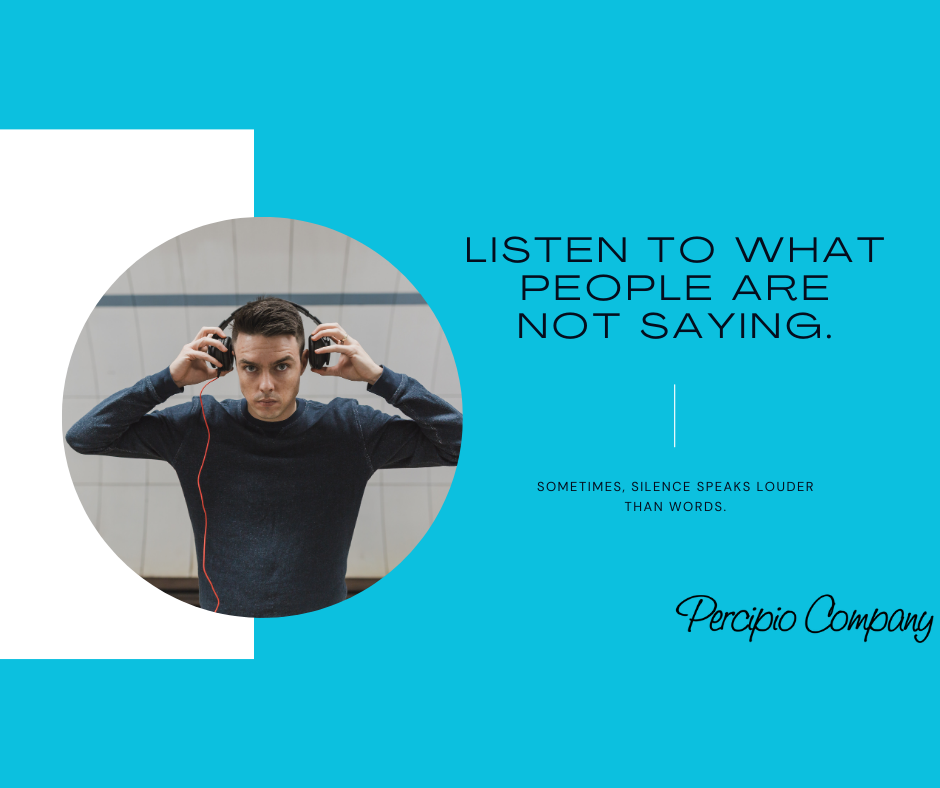What does it look like to move organizations from Bias to Belonging®? To a place where employees can be who they are and can see the importance of their own role in the organization’s mission. One where decisions are understood and where people work in a way that allows for freedom and creativity. Sounds like a great place to be. What does it take to get there? This is one of many success stories of work the Percipio Company delivers for our diverse clients.
A Case Study
 In this case, we found ourselves engaging with a proactive client that wanted to go from good to great. They were willing to dedicate time, attention, resources and not look for a check-the-box solution. The company leaders believed that good enough wasn’t good enough and that we all have room to grow. Developing culture at work is not a singular event or training. Inclusive Leaders know that creating space for introspection and sharing allows for stronger connections and belonging within the workplace.
In this case, we found ourselves engaging with a proactive client that wanted to go from good to great. They were willing to dedicate time, attention, resources and not look for a check-the-box solution. The company leaders believed that good enough wasn’t good enough and that we all have room to grow. Developing culture at work is not a singular event or training. Inclusive Leaders know that creating space for introspection and sharing allows for stronger connections and belonging within the workplace.
This was the situation of one such company that the Percipio Company partnered with over the past year. When we began working with them, they were already sitting on a strong foundation. According to Glass Door, it was a place that 83% of employees would recommend to a friend and 94% approve of the CEO. It was rated 4.3 overall (out of 5), with 4.7 in Diversity and Inclusion, 4.7 in Work/Life Balance and 4.4 in Culture & Values. Many companies aspire to have the culture that this organization already had. They chose to look at the thornier issues of their company and create space to have the difficult conversations as part of an integrated on-going plan, with high involvement from employees at all stages.
Let’s start with their goal of having a stronger sense of Belonging in the workplace. Belonging is the elusive, and too often aspirational, B in the DEIB equation. At the Percipio Company, we’ve broken down Belonging into four categories, Identity, Agency, Power and Flow. Each of these elements builds upon each other, so we begin with strengthening Identity before moving to the other categories.
The Belonging Assessment in Action
 In order to understand the different categories, we developed this Belonging Assessment as a starting place to reflect on where you see yourself and others in the workplace. The assessment provides a score for each of the four areas of belonging as well as an overall score. When a single employee takes it, it reflects where they see themselves within the ecosystem of their workplace, and where they feel empowered or disempowered to take risks, to be themselves or to offer feedback. When an entire company takes the Belonging Assessment, we can see patterns that point to concrete and specific changes that could be made in the workplace to increase belonging.
In order to understand the different categories, we developed this Belonging Assessment as a starting place to reflect on where you see yourself and others in the workplace. The assessment provides a score for each of the four areas of belonging as well as an overall score. When a single employee takes it, it reflects where they see themselves within the ecosystem of their workplace, and where they feel empowered or disempowered to take risks, to be themselves or to offer feedback. When an entire company takes the Belonging Assessment, we can see patterns that point to concrete and specific changes that could be made in the workplace to increase belonging.
In our time with this company, we used the scores on the Belonging Assessment to show us where to direct our attention and find out more. In this organization, although their Glass Door ratings were high, a deeper look through the Belonging Assessment showed that there were areas in Power and Flow that could be improved.
The Discovery Stage. Gather Data.
To take a deeper look at each of these categories, we conducted focus groups across the organization. Like many companies, this one has a primary office and geographical location (whether employees are in-person, remote or hybrid) and then smaller numbers of employees across the United States and across the globe. Focus groups allowed us to hear at greater length from employees who might not represent the majority of the organization but are critical voices. 
From the focus groups interviews and the Belonging Assessment, we created a three session workshop series for all employees over a period of a year. Because of the global location of employees and the desire for cross-functional groupings, we led 11 sessions across 10 timezones to allow for regionally diverse groupings and for employees to work with each other in different teams than usual.
The series aimed to equip them with information and tools based on the study of unconscious biases. The focus was on staff’s connections to race and gender, institutional biases, strategies for mitigating workplace biases, and psychological safety. In short, we wanted to provide them with common language and understanding for looking at unconscious biases that were appearing in their workplace and to begin to create actions to address those biases.
Client Quote
In our partnership with the Percipio Company, we valued the chance to bridge connections among our global workforce of nearly 300. Guided by Matthew and his team, the focus groups and learning series laid essential groundwork for belonging. They also emphasized the importance of fostering equitable and inclusive practices and opportunities throughout our organization. Empowered by the experience, we have started implementing the shared principles into our organizational culture, and are already witnessing positive results.
LaCheka Phillips
Director of Equity, Inclusion, Diversity and Culture
Bias in our Brains, Bias in our Actions
Unconscious biases appear in all our interactions. Our brains are wired to make patterns, judgements and conclusions before we consciously notice we are doing it. Recognizing this and giving language and examples to the more common kinds of biases in the workplace allows employees to identify this behavior in themselves and in the systems that surround them. These systems might have been set up for good reasons – most often efficiency or simplicity – but they reinforce biases that lead to poor decision-making, increased employee turnover and less ability to fulfill a company’s mission.
 A common workplace bias is Proximity Bias, or relying on whoever is nearest to you, whether that is for a new opportunity or in making a decision. In workplaces that are increasingly global and that may be remote or hybrid, this bias can occur easily if companies are not intentional about mitigating it. This is why in our design, we made sure the totality of the company was represented and that we had sessions across many time zones. While it’s not always easy, the best practice is to allow the nature of the work to dictate the where. Not a preexisting rental agreement or unused square footage.
A common workplace bias is Proximity Bias, or relying on whoever is nearest to you, whether that is for a new opportunity or in making a decision. In workplaces that are increasingly global and that may be remote or hybrid, this bias can occur easily if companies are not intentional about mitigating it. This is why in our design, we made sure the totality of the company was represented and that we had sessions across many time zones. While it’s not always easy, the best practice is to allow the nature of the work to dictate the where. Not a preexisting rental agreement or unused square footage.
Moving Businesses from Bias to Belonging®
During our sessions together, employees spoke of how the company’s framing and professional norms were US-centric and did not reflect circumstances in other geographical contexts. One spoke of being expected to work on a day that was a national holiday where they lived. These are situations that happen in many companies but often go overlooked. Fortunately, once these examples of biases have been named, they can easily be mitigated, which increases belonging and also shows in concrete ways how employees are valued. 
Employees also spoke about the need to build connection and the need for time that is relational instead of transactional. Groups proposed a variety of potential solutions from changing their About Me pages to including optional in-person time after a meeting for a walk, a coffee or another activity that values building relationships.
As a result of our time together, employees developed a common language for talking about biases, named biases that were occurring in the workplace and created next steps to remediate these, whether it was a simple change in behavior or a redesign of a company policy or procedure. This is how businesses move from Bias to Belonging® when partnering with the Percipio Company.
Do you want to learn more about belonging?
Our belonging e-book is a free downloadable that dives deep into each of the four cornerstones of belonging and how those come into play in the workplace. This is an incredible resource if you’re interested in learning more about what the work of belonging actually looks like and how we move organizations from bias to belonging®

Percipio Company is led by Matthew Cahill. His deep expertise in cognitive, social, and workplace biases is rooted in the belief that if you have a brain, you have bias®. He works with executives to reduce mental mistakes, strengthen workplace relationships & disrupt existing bias within current HR processes, meeting protocols and corporate policies. Matthew has demonstrated success with large clients like LinkedIn, Salesforce and dozens of small to mid-size companies looking to create more inclusive workplaces, work smarter, generate more revenue and move from bias to belonging®.





